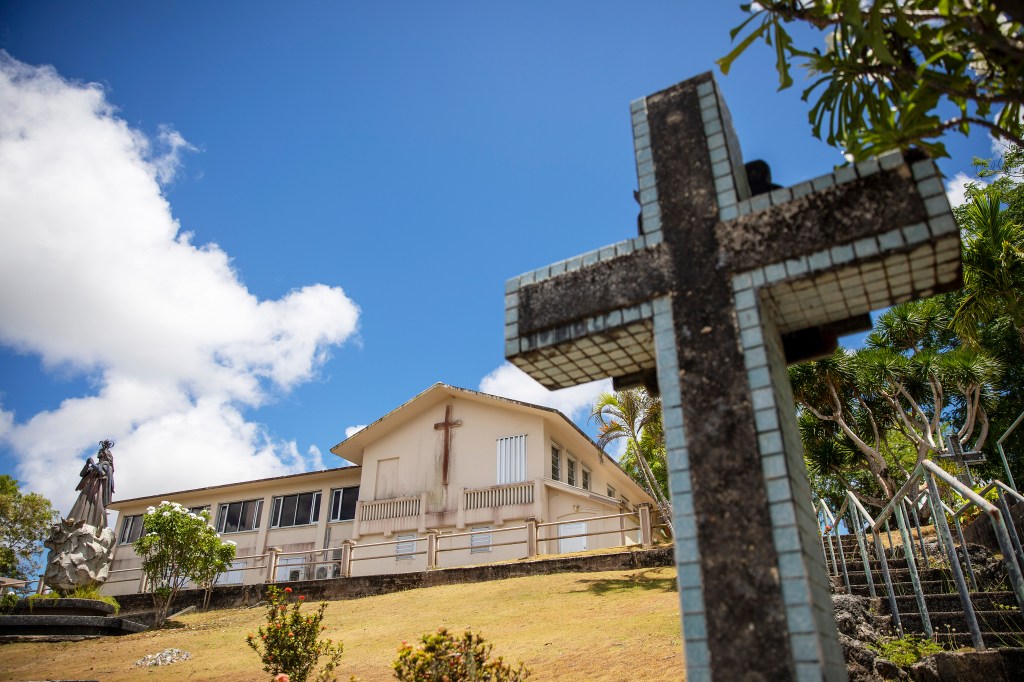Want the best of VICE News straight to your inbox? Sign up here.
It takes eight hours, give or take, to fly across the nearly 4,000-mile stretch of ocean between Guam and Hawaii. The plane tickets can cost upwards of $1,000.
Videos by VICE
But if you live on Guam and you want an abortion in the country that calls you a citizen, that’s the price you have to pay.
The last known abortion provider in the U.S. territory retired in 2018. Since then, the 160,000 people who call Guam home—as well as the 12,000 members of the military stationed there with their families—have had no way to legally obtain an abortion on the island. Departing Guam triggers an obstacle course that has only worsened with the onset of the coronavirus pandemic. Not only is traveling dangerous and expensive, but people who leave and return to Guam must quarantine for 14 days.
“Not working, taking the time off, and finding accommodations—it’s still a huge cost, no matter what bracket you’re in. And the reality is that we have a huge portion of our population that won’t even be able to afford those costs,” said Vanessa Williams, a Guam-raised attorney who runs a practice in Hagåtña, the territory’s capital. “It’s not just difficult; it’s impossible.”
People in Guam could undergo medication abortions, which are induced through pills to end pregnancies that are 10 weeks or less along. But a provider who’s not on Guam would need to remotely prescribe and mail the pills to the island—and thanks to two long-standing laws, it’s effectively illegal to do that.
“We don’t need to wait for the Supreme Court to act to see what a post-Roe world looks like in the United States, because people in Guam are already living there.”
If those laws weren’t in effect, two doctors, who are based in Hawaii but licensed in Guam, say they could prescribe abortion-inducing pills through telemedicine. And on Thursday morning in Guam, those two doctors, represented by Williams and the American Civil Liberties Union, sued Guam’s attorney general and several other territory officials over the abortion restrictions.
“The legal right to abortion is meaningless if people aren’t able to get the care they need,” said Alexa Kolbi-Molinas, senior staff attorney for the ACLU’s Reproductive Freedom Project.
This isn’t the first time that abortion access has vanished on Guam, which is heavily Catholic. And court records from that time paint a grim portrait of what happens when desperate people are driven to extremes.
In 1990, the territory outlawed abortions except when pregnancy would endanger the mother’s life or “gravely impair” her health. As part of a lawsuit over that ban, a Guam OB-GYN detailed what happened to one of his former patients, a 34-year-old woman from a neighboring island who tried to perform her own abortion after being unable to obtain one legally.
“She induced an abortion on herself by inserting a sharpened stick coated with local herbal medicines into her uterus. Severe infection set in and after three weeks of hospitalization and intensive antibiotic treatment on her home island, she was transferred by plane to Guam,” he wrote in a declaration. “She required two separate surgical operations: complete removal of all of her reproductive organs and drainage of diffuse abdominal infections. She spent a total of five weeks in and out of the hospital.”
The woman ultimately survived. In 1992, after a court struck down the Guam ban, the Supreme Court declined to revive it.
Over the last few years, a few states have flirted with the prospect of becoming the first state to have no abortion provider since Roe v. Wade legalized abortion nationwide in 1973. But none has gone as long without a provider as Guam.
“We don’t need to wait for the Supreme Court to act to see what a post-Roe world looks like in the United States, because people in Guam are already living there,” Kolbi-Molinas said.
Between 2008 and 2017, about 200 to 300 abortions were performed every year on Guam, according to the ACLU’s lawsuit. Most took place in the first or second trimester of pregnancy. And almost 60 percent of the people who underwent abortions identified as Chamorro, an Indigenous group that has lived on Guam for millennia.
The Hawaii doctors behind the lawsuit, Bliss Kaneshiro and Shandhini Raidoo, estimate that before 2018 abortion providers in Hawaii saw at most one patient from Guam per year; usually, that person’s pregnancy included a fetal anomaly that demanded they consult with a specialist, according to the ACLU’s lawsuit. Since mid-2018, Kaneshiro and Raidoo said that, between themselves and their colleagues, they’ve seen just between five and 10 abortion patients from Guam.
But every month, they field several calls from people who are in Guam and searching for abortions. Some callers are in the military, which blocks its medical facilities from performing abortions except in cases of rape, incest, or life endangerment. (Military insurance also won’t cover abortions except under those circumstances.)
“They are usually, understandably, devastated that they can’t get the care they need,” Raidoo said. “Some people are able to work with the funds that they have or with their families to be able to afford to fly over. But there are many people who cannot and have no other option.”
No one knows for sure what’s happening to those individuals. They could be searching for abortions in nearby countries, like the Philippines, where it’s illegal but readily available, or Japan, where it’s legal but permissible only under certain circumstances. They could be continuing pregnancies that they don’t want, although it’s far easier for people to safely perform their own abortions today.
The first law being challenged by the ACLU dates back to 1978 and requires that abortions be performed in a “physician’s adequately equipped medical clinic or in a hospital approved or operated by the United States or this territory.” The second law, from 2012, requires that an abortion patient be counseled, in person, about the procedure at least 24 hours before the abortion itself.
Medication abortion didn’t even exist in 1978, but they’re overwhelmingly safe and deeply popular. Recent data indicates that they accounted for nearly 40 percent of all abortions in 2017. A landmark 2018 report from the National Academies of Sciences, Engineering, and Medicine also found that using telemedicine to conduct medication abortions is about as dangerous as taking over-the-counter medications.
Still, it’s controversial, just like everything else in the U.S. abortion wars. Three weeks ago, during the ongoing coronavirus pandemic, the Supreme Court’s new 6-3 conservative majority agreed to restore FDA restrictions on mifepristone, one of the drugs used in medication abortions, that force patients to pick up the drug in person. Nineteen states have separately banned using telemedicine to conduct abortions.
The Supreme Court’s order won’t impact Kaneshiro and Raidoo, who are part of TelAbortion, an FDA-approved research project. They consult with eligible patients over video, then mail the patients abortion-inducing drugs that they can take on their own. Since 2016, when Kaneshiro and Raidoo joined TelAbortion, they’ve served more than 300 patients through the program.
“In a lot of ways, I don’t think we’re trying to do anything too extraordinary,” Kaneshiro said. “We’re trying to get basic reproductive health care to a part of the United States.”
For Williams, the Guam-based lawyer, the ACLU lawsuit isn’t just one more front line in the nationwide battle over abortion—it’s also about the intersection of women and Indigenous people’s rights, and how, when abortion is curtailed, those groups often bear the brunt. A committed local advocate for women’s rights, Williams grew emotional as she spoke about Guam’s high rate of sexual assault. In 2019, the island was rocked by the case of a local 12-year-old girl who’d been raped, impregnated, and unable to secure an abortion.
“Any deprivation of any constitutional rights should be an outrage to any citizen,” Williams said. “It’s not getting the attention it should.”
“The fact that it isn’t is a reminder that, as Indigenous people, we are often treated as less than full citizens.”




